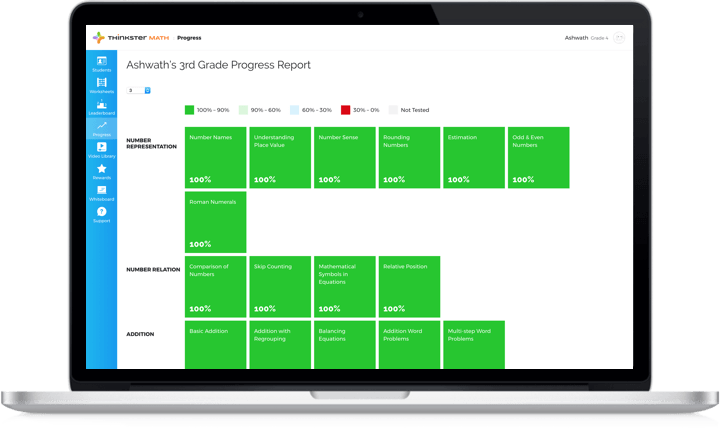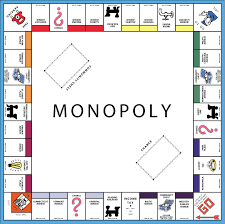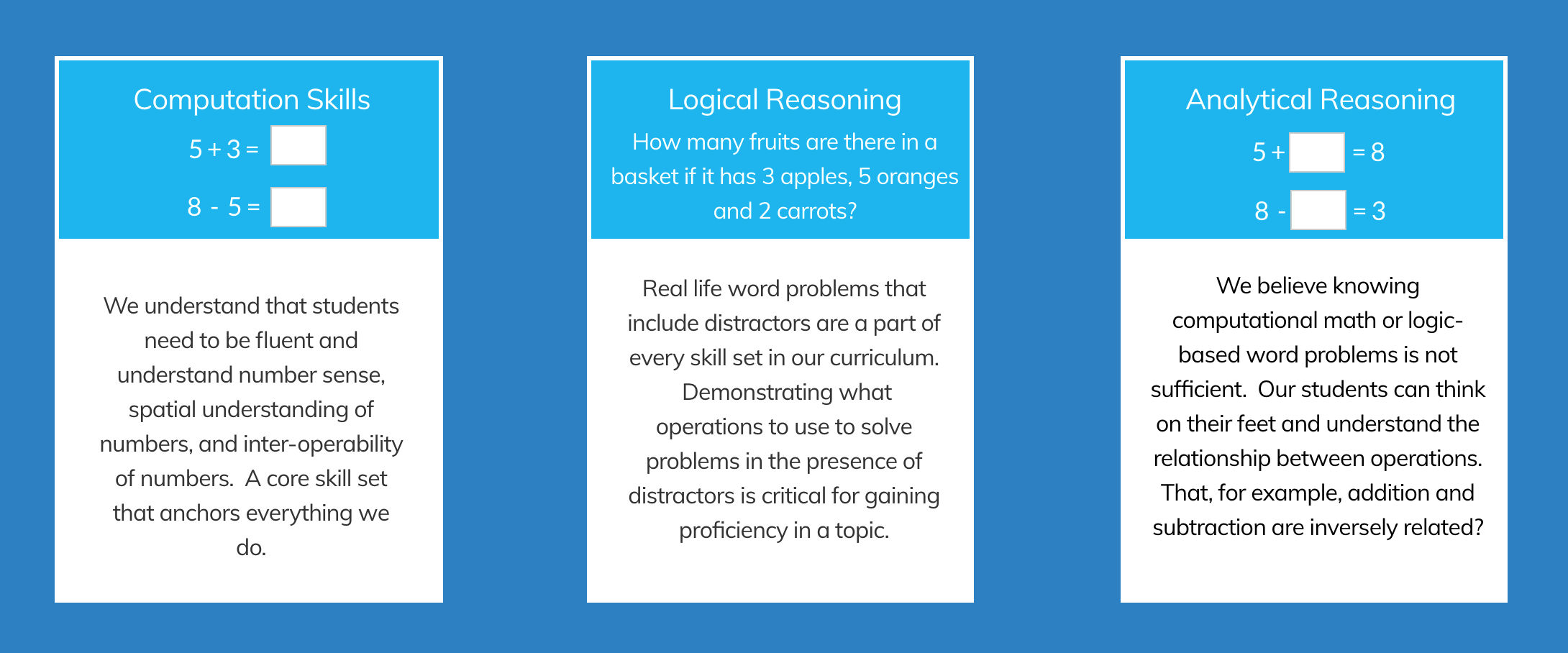

Last Updated on August 31, 2021
When your child is struggling in school and needs math help, it can be challenging to find the best solution for them. When you start looking online, the thousands of results that show up only make it more confusing.
With so much information out there, it’s hard to know what works and what doesn’t.
Don’t worry. This is not an uncommon problem. In the book, “Why is Math Hard for Some Children?” where more than 35 world-renowned Math researchers shared their thoughts, they conservatively estimated that 25%-35% of all students have difficulty with math.
At Thinkster, we want to cut through the clutter. That’s why we provide quality math help to your student so that you can see improvements in not just their math performance but also their classroom engagement, overall confidence and even critical thinking skills. We know what it takes for your student to not only get immediate help with their studies but to master math skills for long-term success.
Our approach to providing math help to students is based on well accepted and rigorous academic research, published by the National Institutes of Health, that has been conducted over the course of several decades. Based on well-known research recommendations, We’ve spent years figuring out how to provide the best help for students, and today we are sharing our top 105 tips on what really works when your child needs math help. Following these steps will surely guarantee that your student will see a significant improvement in their math abilities.
An important first step in finding math help is to be sure you are providing assistance at your child’s level of need. This goes beyond their grade level.
Whether you are looking for a physical tutor, online tutoring program or extra worksheets for added practice, it’s good to know your student’s current level of comprehension and what they should be learning.
For example, what specific math concepts does your student struggle with? What math topics do they have a strong foundation in so that they can be used as anchor points to build additional skills? These are some of the questions we focus on immediately as soon as you enroll your student in our program.
This allows you to set goals that will help accelerate your student’s learning.
The Thinkster online math tutoring program does just this. After you register, your student completes a skills assessment online. Then, a Thinkster Academic Advisor will meet with you to review the results including a review of our patent-pending Progress Matrix that gets explicitly generated for your son/daughter. Your dedicated tutor will then provide you with a personalized learning plan that will address your student’s individual needs.

We really care about the performance improvement of each student in our program. This is the reason why we match your son/daughter with a dedicated tutor, someone specifically assigned to work only with you throughout your engagement with us, to help you reach your goals.
How would you feel if you were offered the chance to drive in a new city, without a map, as soon as you arrived there?
Nervous? Not really sure that you want to have that experience? Perhaps both?
This is how students feel when they get exposed to a new math topic, and then someone tells them to figure out an answer to a problem. There is a vast difference between understanding the theory behind a concept and actually knowing how to solve math problems involving that concept.
Let me give you an example.
Imagine that you have never driven a car before and someone showed you how to drive one. You were shown that you simply need to hold the steering wheel to navigate the car and then press on the gas pedal to accelerate and the brake pedal to stop. Does this mean that you feel great and comfortable when you are to asked to drive the car on the highway immediately?
I am guessing not.
This is why we have instructors guiding you through the process of learning to drive a car. The theory was simple and easy. Actually driving a car immediately after being taught to drive one? Complicated!
This is why we teach our students the methods they can use to solve a math problem. If they are stuck solving a problem, there is always a video tutorial attached to every math problem showing your student exactly how they can solve a similar math problem. This way, when your student needs math help, they do not remain frustrated.
Wait. We don’t just stop with just showing any video tutorial. When your student needs math help, we offer multiple strategies to solve the same exact type of problem, each through different video tutorials. Each math problem thus comes with links to multiple video tutorials teaching different approaches to solve a particular problem type.
Some math worksheet based tutoring companies and others who also provide math help think that allowing a student to discover solutions to math problems on their own will help them become self-reliant and more confident. It may work for a few students, but there are sufficient research and evidence to indicate that students show significant improvement in math learning when they are explicitly taught how to solve different types of math problems. We believe that you can learn to speak a new language more quickly, fluently, and correctly when someone guides you through the process. Learning math, which we think is a language too, should be no different.
Imagine that you are getting ready for the family game night. Your kids are asking you to play Monopoly, the board game involving math, real-estate, and money! If you have a neighbors daughter, Lucy, join you for the board game and she has never played Monopoly, what would you do?
 Tell Lucy every little detail and nuance about the game and spend 30 minutes explaining everything before you begin? Or do you spend some time giving Lucy a broad overview of the rules of the game and then tell her you will explain more as you play the game?
Tell Lucy every little detail and nuance about the game and spend 30 minutes explaining everything before you begin? Or do you spend some time giving Lucy a broad overview of the rules of the game and then tell her you will explain more as you play the game?
The chances are that you will do the latter. It’s not like Lucy is not intelligent enough to understand all the details if you would have taken the time to explain to her. It’s just that it would not make much sense to Lucy if you tell her many details of the game that do not provide contextual relevance until she starts to play the game.
Learning Math and providing the right kind of Math help at the right time is not much different. We do not want to overwhelm your son/daughter will all the intricacies of each topic and concept at the very beginning. It will just make them get bored of Math and perhaps even get frustrated with it.
This is why we build teaching sequences. These are math concepts that have been ordered in a master sequence, in a scaffolding pattern, so that your student can begin to develop a solid foundation. Each topic and concept is taught with the goal to eliminate any misunderstanding. We also carefully craft and personalize the sequence of math concepts that we teach to every student so that we can accelerate their learning in the shortest period.
Let me give you an example.
If you were to learn addition of numbers, we would start from the addition of single digit numbers like 2+3 and 3+1. We will then offer problems using numbers that involve carry-over at the units place like 3+19 and 6+17. Once a student gets comfortable with the carryover of numbers at the units place, we then begin to introduce the addition of two-digit numbers like 87+36 and 46+59 as these involve carry over at both the units and the tenths place. There is a deliberate sequence to the way we introduce incrementally challenging math problems so that your son/daughter does not feel overwhelmed with the levels of difficulty they will encounter and will see their confidence getting boosted with the way we provide math help to them.
It does not matter how many math problems your son/daughter will solve if they do not get a solid conceptual foundation in math. Without this, they may remain confused about some topics and concepts, have learning gaps, and may also fail to keep up with previously mastered content. This is why getting the right kind of math help is also crucial for achieving mastery.
At Thinkster Math, we believe in making sure that every student can answer math problems using a variety of approaches and strategies and not think that there is only one way to solve any given problem.
We do not introduce variety just for fun.
Researchers at MIT indicated that “through separate studies involving behavioral experiments and brain-imaging techniques, researchers found that a distinctly different part of the brain is used to come up with an exact sum, such as 54 plus 78 than to estimate which of two numbers is closer to the right answer.” They went on to state that “developing the latter skill may be more important for budding mathematicians.”
As you can see, for your son/daughter to get a strong conceptual foundation, we make them solve problems that use different parts of the brain. It is well understood that solving computational problems like addition or subtraction of numbers use different parts of the brain compared to solving story or word problems. Word problems force a student to decipher language, remove unwanted information, decide which mathematical operation to use and then use their math computation skills to solve the problem at hand.
We do this at Thinkster Math routinely.
For example – for problems as simple as adding two numbers, we provide the following types of problems.

You can quickly see that solving for 5 + “blank” = 8 immediately forces a student to have a conceptually strong understanding of both addition and subtraction to be able to answer the problem correctly.
Similarly, solving the word problem above and understanding that carrot is not a fruit and is irrelevant to solving the problem is a critical foundational skill that students need to learn. This is the kind of skill that helps them solve real-world problems in life as well.
For a lot of students, math is a hard subject to learn and can cause stress. Added stress makes it harder for your student to learn math – or any subject for that matter.
It is not always possible to create a calm, patient environment in a traditional classroom. The classroom is full of distractions that keep students from learning and there is usually only one teacher to get everyone back on track.
Learning at home can be an excellent way for your child to learn and practice math in a distraction-free environment they are more comfortable with.
Working on math at home is also a great way for your student to learn at a slower pace if needed – either with their online tutor or with do-it-yourself worksheets.
Being able to complete math problems quickly is not always an indicator of real math knowledge, according to research from Jo Boaler, a professor of mathematics education at Stanford Graduate School of Education.
Taking time to truly understand difficult concepts can lead to more math knowledge and mastery. Then they can take their new skills back into the classroom with confidence.
The theory is great. Practice is what makes you perfect. When it comes to math help, this is entirely true.
Dr. Benjamin Bloom, a professor of education at the University of Chicago, published a landmark book in 1985, Developing Talent in Young People, which was considered a ground-breaking study of the childhoods of 120 exceptionally talented young people. These 120 people had won awards in various fields ranging from music and the arts to mathematics and neurology. He found no relationship between typical factors like IQ or intelligence and the reason for exceptional performance. There was something else in common though: Everyone of the exceptional people had practiced immensely, had great teachers, and had great family support throughout their early years.
Practicing math can help your student get beyond rote memorization and truly learn the math processes behind the solutions. In the research from Boaler mentioned above, it is noted that “the best way for students to know math facts is by using them regularly….”
You can find hundreds of math worksheets online for your student to practice. There’s really no limit to what’s available. Just be sure to get these from a reputable source, provide a variety of math problem types and also offers an accurate answer key along with the methods and strategies explained well to solve these math problems.
If you don’t know how to find a reputable source or are ready to have your child work with a dedicated tutor, Thinkster online math tutor program provides unlimited math help via worksheets and a dedicated tutor for each student. Thinkster’s Math Worksheets come with a variety of problems for grades K-8, included attached video tutorials that explain different problem-solving strategies and also provides these in a sequence that is crafted for each student’s learning needs.
Imagine you are swimming in the sea. If you do not know if you are swimming to the shore, you could be swimming in circles.
You have to keep raising your head now and then to make sure that you are reaching your destination.
Math is no different.
Your son/daughter can do a lot of math problems and practice them regularly. But if they are not getting daily feedback that helps them understand where they are making mistakes and what strategies they could employ to solve problems efficiently, it could actually hurt their progress.
At Thinkster Math, in addition to getting a daily assignment of highly personalized math worksheets, your student will also get daily grading and feedback on these worksheets from their dedicated online math tutor. This helps them regularly keep up with their progress without having to wait for the next tutoring session.
We also make sure that your son/daughter gets a periodic review worksheet that makes them solve math problems from multiple math concepts that they would have learned in the previous few weeks. Each review worksheet is also followed by a unit assessment to ensure that your student is moving from practice level proficiency to gaining mastery of a topic. We use concepts like checking “Fade over Time” to ensure mastery of concepts. This method makes sure that your student can still remember the techniques and concepts they have learned a few months back and can apply it to solve problems later on in the program without any difficulty.
As a parent, you can also see the feedback from your child’s tutor daily through a Parent Insights App, a smartphone app that provides daily notifications. This app allows you to keep track of your child’s progress through the dynamically updated progress report in addition to showing you the actual problems on which your tutor has given feedback to your son/daughter. It’s like having a tutor in your pocket to reach out to at any time!
We all know that we learn better when we’re doing something that we enjoy.
Your student may not love math as a school subject, but online programs allow them to learn math using a digital format they enjoy.
Children today are accustomed to digital and online programs and often prefer to have information delivered this way.
The Thinkster technology-enabled program and tutoring apps provide just the right platform for your student to enjoy what may be a difficult subject. Adding in our gamification elements with the student Leaderboard, $5 monthly gift cards for doing math consistently and correctly, and a badge system that helps your child get Bronze, Silver, or Gold medals, all leads to even more engagement and use.
There is no greater asset than the one that allows you to measure and quantify the amount of learning that has happened.
This is very important to have, but very difficult to make available in a useful format that actually helps to accelerate learning.
Progress Monitoring not only allows teachers to effectively create highly personalized learning plans for each student but is the foundation needed for supporting your own goals to accelerate your child’s learning.
Any student progress report should have the following –
At Thinkster Math, your dedicated tutor will not only send you a weekly report of your student’s progress (see below for example report), but our Dynamic Progress Matrix, available to you all the time, does all of the above and much more. It provides you a live, constantly updating report of your student’s progress over time. This is as close to getting you a near-guaranteed performance improvement that is available for you to track – transparently. We do this because wanting your son/daughter to show progress should not just be a wish, but something that you should have proof of when you enroll with any tutoring company.
 Find an Awesome Math Tutor
Find an Awesome Math TutorThe right math tutor can make all the difference in getting the right math help for your student. This is the person you are trusting to provide one-on-one feedback and directly work with your child to help them master new math concepts.
Your math tutor should be aware of your child’s grade level and provide a personalized learning plan for them. Your tutor should also have a good reputation and extensive knowledge of the math concepts that your student is currently learning.
Research also shows that a good tutor can help alleviate a student’s anxiety about math, providing confidence that extends beyond one test or math worksheet.
Working with one of our skilled online math tutors provides the same benefits of an in-person tutor while allowing for even more flexibility and accessibility. You won’t have to drive to meet the tutor at a specific place, and you can schedule math learning at a time that works best for your family.
When the teacher is offline, our technology-enabled program supplies your student with unlimited math worksheets to practice on their own time.
Also, you get all the benefits of a well-designed curriculum –
– that is personalized for your child,
– periodic reports and a dynamic proficiency matrix that allows you to monitor improvements that your son/daughter make weekly,
– a custom and purpose-built parent insights smartphone app,
– a dedicated tutor to monitor your child’s work daily and customize the next set of math worksheets,
– built-in video tutorials that teach multiple strategies and provide math help at the point of learning and,
– a high degree of motivation and engagement for your student with leaderboards and reward cards.
When the teacher is offline, our technology-enabled program supplies your student with unlimited math worksheets to practice on their own time.
The Thinkster online math tutoring program combines all of the things above into one simple, customized tutoring app for your K-8 student. Why not give it a try if for free and experience the benefits for your child?
Sources:


